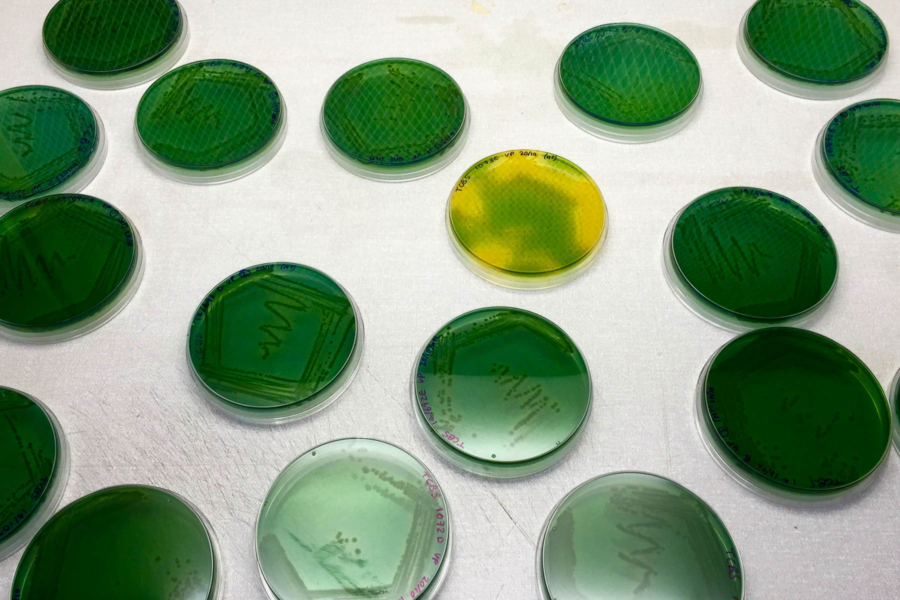Five facts about Vibrio
Vibrio bacteria is a growing public health concern, but infection can be avoided

As the Chesapeake Bay watershed heats up for the summer and people flock to its shores, a bacteria called Vibrio has people thinking twice before cooling off in the Bay water. Vibrio is an infectious bacteria present in brackish coastal waters, such as the Chesapeake Bay and its tributaries. As waters warm, concentrations of Vibrio rise and spark health concerns.
A Vibrio infection, called vibriosis, is a serious illness that infects thousands of people each year. Vibriosis can occur when a person eats tainted shellfish or swims with open wounds in contaminated waters. Learn about the bacteria—and how to avoid infection—with this list of five Vibrio facts.

1. Vibrio is a naturally occurring bacteria.
Vibrio bacteria loves to attach itself to tiny particles in the water, such as loose sediment or plant matter. Once it has attached itself to these particles, Vibrio hitches a ride on native microscopic animals called copepods, which feed on the Bay’s supply of algae. As more algae is produced in the summer time, copepods enter a cycle of rapid reproduction, death and decomposition, releasing large amounts of Vibrio directly into the waterways in the process. About 80% of Vibrio infections occur between May and October, when Bay temperatures are at their warmest and algae is most abundant.
While there are more than 80 species of Vibrio present in our waterways, according to the Center for Disease Control and Prevention (CDC), only 12 types can infect humans. In North America, three strains of Vibrio bacteria have been of concern in recent years: Vibrio parahaemolyticus, Vibrio alginolyticus and Vibrio vulnificus. In 2014, these three species accounted for over 75% of all domestically reported cases of Vibrio.
2. Vibrio levels can be predicted just like the weather.
A forecast map by the National Centers for Coastal Ocean Science (NCCOS) provides the probability of Vibrio occurring throughout the Bay up to 48 hours in advance. It is a fun and valuable visualization for those curious about the concentrations of Vibrio near them.
While a valuable tool, it is important to remember that this map does not reflect actual measurements of Vibrio levels in the water. Rather, NCCOS takes into account related environmental factors such as recent rainfall, water temperature, nutrient levels and salt concentrations to render a predictive model of the likelihood of Vibrio occurring. The Maryland Department of the Environment reminds recreators that “there is no known numerical threshold or standard that can be linked to risk of infection from Vibrio bacteria.” Vibrio can be dangerous even in small amounts, so it is best to take precautions regardless of risk level.
3. Vibrio bacteria is primarily foodborne, but it can infect wounds as well.
Of the estimated 80,000 cases of Vibrio that occur nationwide each year, the CDC estimates that 52,000 of these cases are the result of eating contaminated food, particularly oysters, due to their incredible ability to filter water. Just one adult oyster can filter 50 gallons of water in a day, improving water quality by removing excess plankton, algae and nutrients from Bay waters.
As these filter-feeders clean, Vibrio bacteria can concentrate heavily in the oyster’s tissue. Vibrio concentrations in oysters can be 100 times higher than the surrounding water. Consuming raw, infected oysters then transfers these high concentrations of Vibrio throughout the human body.
Though not as common as food-borne transmission, infection can also occur from swimming in contaminated waters with an open wound.
Vibrio infections are uncommon and, in most cases, highly treatable, but can be fatal. The severity of Vibrio infections can differ dramatically, so it is important to familiarize yourself with the symptoms. When ingested, Vibrio can induce symptoms similar to those of food poisoning or influenza, including nausea, stomach cramping, diarrhea and fever. If Vibrio comes into contact with a wound, you might experience swelling, redness, blistering or pain in the wounded area. Symptoms can begin anywhere between 12 and 72 hours after exposure. Those with weakened immune systems or chronic liver disease are more vulnerable to infection by the bacteria than healthy individuals.
If you experience symptoms of Vibrio or believe you have been infected with Vibrio, consult a health care provider for immediate treatment. Make sure to let your doctor know that you have recently come into contact with potentially contaminated water or eaten undercooked shellfish.
4. Recent increases in Vibrio are a result of climate change.
While Vibrio occurs naturally in the Chesapeake Bay, the increase in recent years is a direct result of climate change and pollution. As Bay temperatures rise and nutrient pollution from urban stormwater, agricultural runoff, sewage and animal waste continues to increase, algal blooms become more frequent.
As sea levels continue to rise, coastal bodies of brackish and saltwater are beginning to spill into freshwater streams around the country. Because Vibrio thrives in areas of high salinity, their habitat is likely to grow in size in years to come, causing people living further inland to also be at risk for infection.
5. There are steps you can take to protect yourself from Vibrio.
While the risk of contracting Vibrio can never be completely eliminated, there are some simple rules you can follow to avoid you risk of infection by these bacteria:
- Avoid swimming in the Bay for 48 hours after rainfall. In the days following a rainfall, bacteria levels increase dramatically as a result of stormwater runoff. If you are unsure as to what this means for your local waterways, consult the Vibrio forecast map.
- Avoid raw and undercooked shellfish. Get creative with your oyster recipes. Among Vibrio patients with illnesses linked to oyster consumption, 89% reported to have consumed their oysters raw. You can ensure that your favorite shellfish are safe to eat by broiling, baking, frying or even grilling them at appropriate temperatures before you eat them. Rather than limit your oyster consumption, the summer can afford you the opportunity to introduce some new flavors to your plate.
- Do not swim with open wounds, scratches or ear infections. If this is not possible, cover wounds securely with a waterproof bandage.
- Wear protective equipment. When handling raw shellfish or going for a swim, wear water shoes and gloves to decrease your chance of incurring a wound.
- Pack antibiotic ointment or hand sanitizer. There is no telling when a wound might occur. Always have easy access to antibiotic ointment or hand sanitizer to immediately treat a wound and greatly decrease the risk of infection.
- Shower and wash your hands. The best way to stay clear of any illness is to stay clean, and this goes for avoiding Vibrio, too. Be sure to shower as soon as possible after swimming in the Bay and its tributaries. Wash your hands before handling food, especially shellfish.
- Take on responsibility for our water. Taking small steps such as planting a rain garden, switching to an organic fertilizer or learning to drive in a Bay-friendly way will help keep pollutants out of our environment and bring Vibrio concentrations down.
By following these rules and looking out for any emerging symptoms of Vibrio, there is no reason why you should not be able to enjoy a fun and safe summer on the Chesapeake.

Comments
Take heed...our loved one died as a result of a vibrio infection contracted in the Severn River June 2023.
After an injury believed to be sustained from a barnacle scratch, he was left untreated by any oral or intravenous antibiotics (only received topical care).
Within 5 days, he succumbed to the infection which did not present for 72 hours. Never a fever present, only determined by bloodwork.
I went to a urgent care who would not listen to me about the bacteria and told me to go to the emergency room. I was able to get amoxicillin from a friend which has helped. I will see my doctor tomorrow, What kind of antibiotics should I be taking?
I will sail in Assawoman Bay and the Atlantic Ocean.
This was so helpful! Why isn't this information more widely available.
Thank you!
Your comment has been received. Before it can be published, the comment will be reviewed by our team to ensure it adheres with our rules of engagement.
Back to recent stories